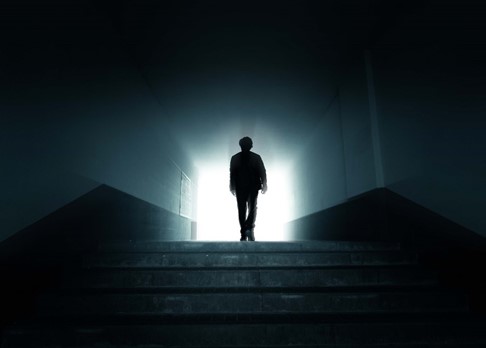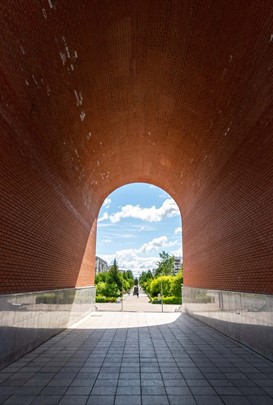I have really missed the liturgical drama of the season and of being with the community of believers who journey with each other over these days, and feeling the movement of our liturgy. I have found it hard to do this on my own. I know we are meant to gather as a community of believers, to speak with each other, to listen to the others’ stories and to touch each other. Our Christian faith is not a solitary one, but a communitarian one. Even though it is Easter, we are still in the desert of COVID – 19 and of not being able to gather. The incarnation, the coming of God into our midst in the person of Jesus and our Christian understanding of God as relational, God Father, God Son and God Holy Spirit, I believe is being more clearly understood in the absence of making God’s presence real in relationships.
 While participating in Fr Richard Shortall’s Holy Week Retreat last week, the image that has remained with me is the one of the tomb, particularly the empty tomb. Presently, I am thinking of our churches as equivalent to the empty tomb. And while I recognise we are resurrection people, it is the Cross with which we sign ourselves, generally before and after prayer, that I have been reflecting on.
While participating in Fr Richard Shortall’s Holy Week Retreat last week, the image that has remained with me is the one of the tomb, particularly the empty tomb. Presently, I am thinking of our churches as equivalent to the empty tomb. And while I recognise we are resurrection people, it is the Cross with which we sign ourselves, generally before and after prayer, that I have been reflecting on.
The mission and resurrection of Jesus are both a message of hope to humanity and a call to conversion: to renounce the sources of violence and to look for new constructive ways of addressing the pain and anger we see in our world and our church. Jesus’ response to violence was not more violence but an act of transcendence that set humanity on a new path forever. A spirituality of nonviolence roots the nonviolent journey in the profound mystery of encountering and engaging with the woundedness and sacredness of all beings. It is a path to transformation, a transformation that rises up from our living the paschal mystery – the suffering, death and resurrection of Jesus and of each one of us.
Richard Rohr points out that Christianity is the ‘Way of the Wound”. We have a crucified Christ who hangs on a cross in our churches. Mary stands at the foot of this Cross holding the wounds of her son and of humanity. We worship an un-natural image of God – the scourged Christ who liberates and saves humanity, who hangs as a contradiction. We sign ourselves with the Sign of the Cross at the beginning of and throughout our Christian rituals. This was the first prayer my parents taught me as they said my night prayers, and this was the first prayer I taught my children as I held their little hands and signed them into our faith. They now are doing the same with their children. I recall making the Sign of the Cross with the residents of aged care facilities and those I visited in hospitals when I was a Parish Pastoral Associate. I always felt that this would be the last recollection to leave some of these people as they approached the end of their lives. The cross, a sign of contradiction and suffering is always with us. We know that this suffering is not meant to destroy us but to lead us to redemption.
 Ronald Rolheiser writes in The Holy Longing: “The paschal mystery is a process of transformation within which we are given both new life and new spirit. It begins with suffering and death, moves on to the reception of new life, spends some time grieving the old and adjusting to the new, and finally, only after the old life has been truly let go of, is new spirit given for the life we are already living.”
Ronald Rolheiser writes in The Holy Longing: “The paschal mystery is a process of transformation within which we are given both new life and new spirit. It begins with suffering and death, moves on to the reception of new life, spends some time grieving the old and adjusting to the new, and finally, only after the old life has been truly let go of, is new spirit given for the life we are already living.”
The paschal cycle might be represented as follows:
- Good Friday… “the loss of life – real death”
- Easter Sunday… “the reception of new life”
- The Forty Days… “a time for readjustment to the new and for grieving the old”
- Ascension… “letting go of the old and letting it bless us, the refusal to cling”
- Pentecost… “the reception of new spirit for the new life that one is already living”
Over these Easter days, I have been reading the Plenary Responses from our diocese. I have found this hard going, because of the grief, loss and sadness expressed in so many of the responses to the question; “What is God asking of us in Australia at this time.” Since 1995, our diocese has been subjected to the many allegations of sexual abuse that have occurred in our parishes and schools. This formed part of the many responses from our diocese, along with the stories that were shared.
Putting it into our language this paschal challenge for each of us might be described as:
- Name our deaths
- Claim our births
- Grieve what we have lost and adjust to the new reality
- Do not cling to the old, let it ascend and give us its blessing
- Accept the spirit of the life that we are in fact living
This renewal cycle can become a daily exercise of acknowledging our many deaths and risings, which in turn can lead us to happiness, peace and maturity enabling us to see life as mystery. This is what I imagine happened to the disciples after the death of Jesus and then beyond his resurrection, as they, like us, tried to live their new reality.
During this time of COVID – 19 we appear to be living with doubt, confusion, fear, and anxiety. These are not pleasant daily companions, however the paschal mystery teaches us that we learn to grow through sadness, failure and doubt, and not necessarily through happiness.
As a diocese, we continue to name our wounds and rejoice in our blessings. If we hold our imperfections and allow them to be healed and transformed, we will be renewed, as God is there in our woundedness just as he was on the road to Emmaus, companioning his bewildered disciples. God came to us as a person to show us how to be fully human, to journey and to be transformed. It is in this framework of suffering, death and resurrection that God becomes known to us, and we are called into union with God and with each other. I think one of our challenges is how do we do this together, in communion with each other.
If we do not transform our pain, we will transmit it by blaming the other – our bishop, our clergy, head-office, our schools, the parishioners, and the people who no longer come to church, and this is violence. This dualistic thinking is destroying us. Do we dare to hold our woundedness with dignity but without blame, without answers, without closure, but just hold it?
I believe we are being invited to be compassionate, to embrace our pain and imperfection without judgment, explanation or analysis. We begin our Mass with a communal confession, Lord Have Mercy, Christ Have Mercy. We are being invited to the experience of the Trinity, as a place of communio. Are we able to embrace the healing of woundedness and acceptance in community? It is not about success, but it is about being faithful. We might even be able to move through Ascension and on to Pentecost in the mystery of the paschal cycle. Many of the images of our life here in this diocese are great ones. We are a light shining in this great wilderness. Are we able to see that light and draw others to it? That is one of the challenges for us today; to be energised by our re-imagining.
 We are journeying on the road less travelled and “the ties that bind us are sometimes impossible to explain. They connect us even after it seems the ties should be broken. Some bonds defy distance and time and logic.” (Meredith Grey)
We are journeying on the road less travelled and “the ties that bind us are sometimes impossible to explain. They connect us even after it seems the ties should be broken. Some bonds defy distance and time and logic.” (Meredith Grey)
The following words by Joan Chittister speak to me at this time of our continuing to prepare for the Diocesan Synod:
This is the period when the parts of us
that died with the death of those we loved
rise again in the recollection of past moments
and the tears of past tendernesses.
This is when we know for certain
that every deed we ever do
lives on somewhere
in someone who remembers or lives it.
Death – the awareness of its coming,
the sounds of it around us -
is what calls us to a life beyond apathy,
beyond indifference, beyond unconcern.
Death reminds us to live.
And to finish this Easter message I will use the words of the chorus for the hymn Holy Darkness by Daniel Schutte:
Holy Darkness, blessed night,
Heaven’s answer hidden from our sight.
As we await you, O God of silence,
we embrace you, holy night.
It is hard to embrace darkness and to call it holy, but here we are in the darkness of our reality as a diocese and as a community in a pandemic.